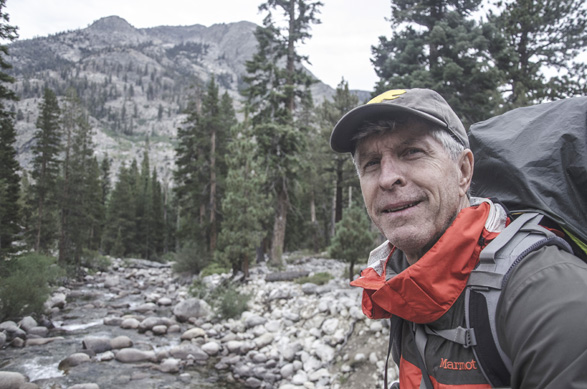
Doug Harnsberger had an idea.
Actually, Harnsberger has lots of ideas. Like returning Hetch Hetchy Valley in Yosemite National Park to its natural state by draining Hetch Hetchy Reservoir and dismantling the O’Shaughnessy Dam—the construction of which, so the story goes, broke an old John Muir’s heart. Harnsberger, a native Californian transplanted to Pennsylvania, is the sole East Coast board member of Restore Hetch Hetchy.
But this story is about Harnsberger’s big idea for a little stone structure—specifically, the John Muir Memorial Shelter, commonly known as the Muir Hut. Located atop 11,955-foot Muir Pass roughly midway along the John Muir Trail in California’s Sierra Nevada mountains—Muir’s “Range of Light”—the granite hut was built by the Sierra Club in 1930 for backpackers seeking shelter from the elements at the barren, exposed pass. It is also the only structure built by the Club to honor Muir.
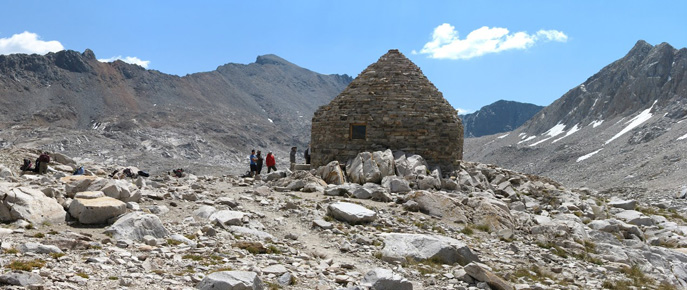
John Muir Memorial Shelter, aka Muir Hut. (Photo by Donn Furman)
Harnsberger was hiking the Muir Trail in 2013 when he encountered the hut for the first time. An architect and architectural historian by trade, he recognized that the hut’s design was exotic. “It wasn’t an American style of design,” he says. “It clearly derived from some other type of stone construction that was both foreign and very likely ancient.”
Turns out the hut, featuring an octagonal base and a steeply-pitched conical roof, was modeled by Berkeley, Ca., architect Henry Gutterson on the so-called trulli, found only in the Puglia region of southern Italy. But Harnsberger didn’t know any of this yet as he spoke with two national park rangers who were doing maintenance work on the hut. What he did ascertain was that the structure had never been nominated to the National Register of Historic Places. There and then, he determined to remedy that state of affairs.
###
In late August, three Sierra Club groups and one National Park Service group hit the trail, bound for Muir Pass. One Sierra Club group approaches from the east, two hike in from the west, and the Park Service contingent comes up from the south. The groups will converge at Muir Pass at noon on August 25, the 100th birthday of the National Park Service, and officially place the Muir Hut on the National Register.
To that end, a Park Service mule is hauling a 110-pound bronze sculpture up to the pass. Designed by Richmond, Va., sculptor Paul DiPasquale, the plaque features John Muir facing longtime Sierra Club director William Colby, who initiated the Club’s annual “High Trips” in 1901 and led his final High Trip in 1930. It was Colby’s vision to build the hut, which appears between the two men on DiPasquale’s bas relief. Just below the hut is Henry Gutterson’s signature.
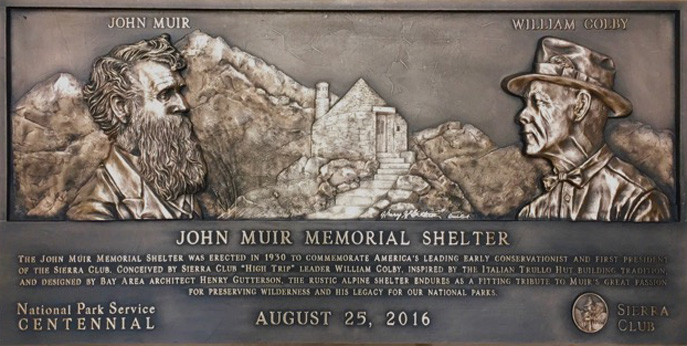
Photo by Doug Harnsberger
In March, Harnsberger shared his concept for the plaque with Sierra Club board member Chuck Frank, who raised the necessary funds for its design and casting from fellow board members and other supporters. “Chuck personally made a critical downpayment on the sculpture in April and then raised the rest of the funds by July,” Harnsberger says. “He’d hoped to join the expedition, but sadly, at the last minute he couldn’t make it.”
###
On August 21, I meet up with Chris Grenier, Leopoldo Hernandez, and Luis Ramirez, who’ve flown in from Chicago for the expedition. Grenier, a software guy and rock’n’roll drummer who sports John Muir-style facial hair, is a volunteer leader with the Sierra Club’s Inspiring Connections Outdoors (ICO) program. Hernandez and Ramirez are high school buds who got turned on to hiking through ICO.
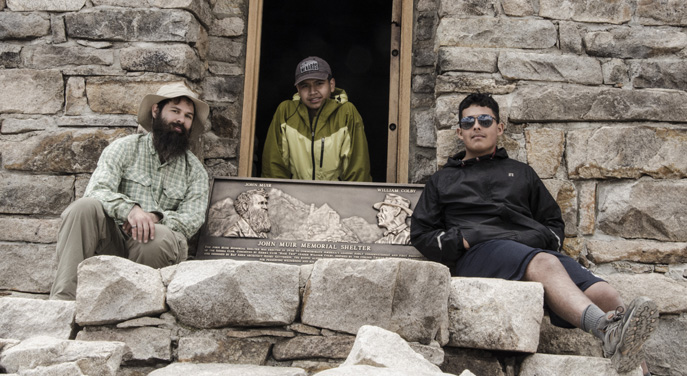
Chris Grenier, Leo Hernandez, and Luis Ramirez at Muir Hut. (Photo by Julia Marshall)
“Chris came to our school and gave a talk about how great it is to spend time outdoors and how much we’d learn,” Hernandez says. “Not a lot of kids were interested—all they know is the city, and they don’t necessarily feel comfortable in nature. But ICO changed my life. My friends think I’m crazy to be spending seven days hiking with a pack on my back the week before I start college, but I’ll do anything to spend time outdoors.”
Ramirez, originally from Mexico City, feels the same way. “I did trail work with ICO in the Bitterroot Mountains in Montana last year, and I’ve been waiting to get back to the mountains ever since,” he says. “I want to keep learning about the environment and helping any way I can. When I’m outdoors in nature it just feels amazing. I think everyone, no matter their background, should have the opportunity to experience wilderness."
He pauses, gazing out the window at the sea of traffic on Interstate 5. "My life is the forest," he says quietly.
A 6-hour drive brings us to Jackass Meadow campground in the Sierra National Forest, where we meet the rest of our group: Harnsberger and his son John, a college sophomore; trip leader Dave Roberts, who gamely volunteered to lead the trip at the last minute after he heard that an "official" leader was needed to make this an accredited Sierra Club outing; Tracey Quigley, a Sierra Club member who grew up in the eastern Sierra; and Julia Marshall, a videographer and veteran who learned her craft in Afghanistan as a combat documentary producer, and who was introduced to the Sierra Club through its Military Outdoors program.
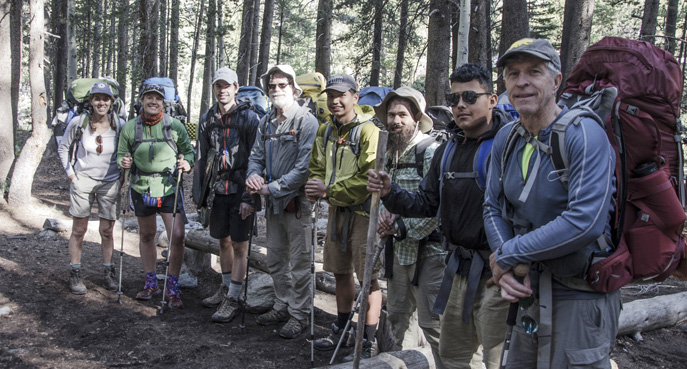
Left to right: Quigley, Marshall, J. Harnsberger, Roberts, Hernandez, Grenier, Ramirez, D. Harnsberger. (Photo by Tom Valtin)
Harnsberger has brought with him a 2x3-foot glossy photo of DiPasquale’s plaque, mounted on foamcore and wrapped in heavy-duty plastic. Just before flying west he’d received word from the National Park Service that the mule tasked with lugging the actual plaque up to Muir Pass would be unavailable. True to form, Harnsberger hastily created a photo facsimile so there would be a to-scale visual at the Muir Hut dedication.
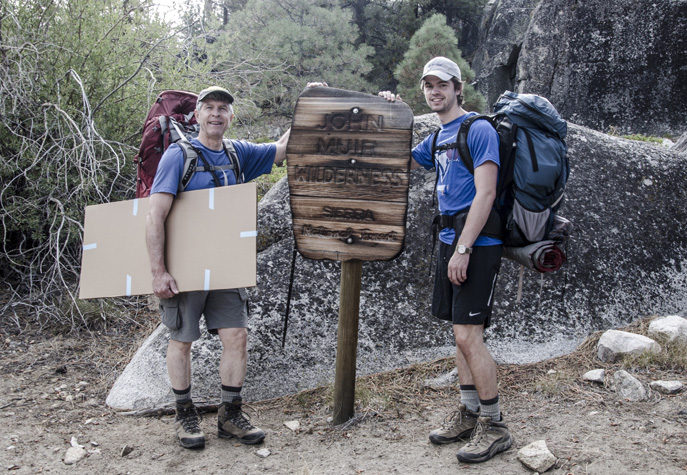
Doug and John Harnsberger with photocopy of DiPasquale bronze plaque. (Photo by Julia Marshall)
###
We hit the trail the next morning after a ferry ride across Florence Lake, a reservoir situated at 7,200 feet whose volume has been so diminished by six years of drought that a large bathtub ring now encircles the lake and previously submerged rock formations have emerged as islands. Some of them are actually pretty cool looking—bleached-white granite shapes rising out of the water—but the sight is sobering to those of us who have seen Florence Lake at full capacity.
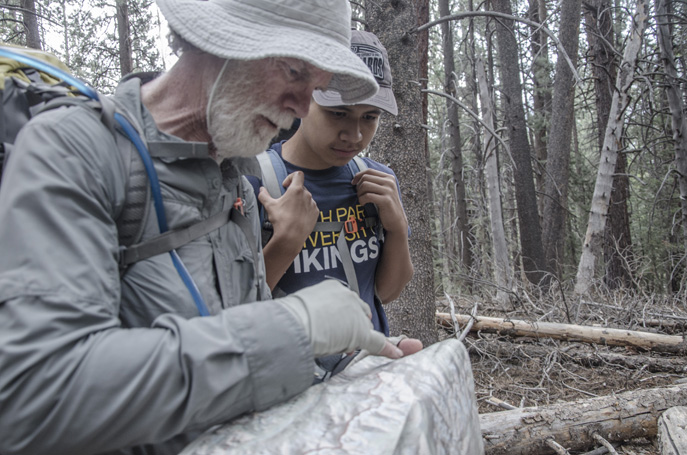
Dave Roberts and Leo Hernandez consult the map. (Photo by Julia Marshall)
But thoughts of California going the way of the Anasazi quickly give way to the zen of placing one foot in front of the other, and for the next several hours we climb steadily upward through a mixed conifer and diciduous forest, with the upper San Joaquin River rushing by in the opposite direction on its way to the Central Valley, San Francisco Bay, and the sea.
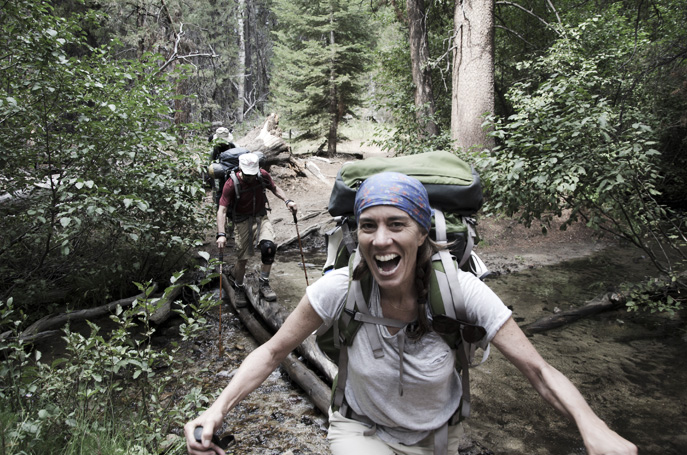
Tracey Quigley on the trail. (Photo by Julia Marshall)
Late that afternoon, after a surprise hailstorm, we catch up with a Sierra Club foursome who’d hit the trail one day ahead of us. Three of them are pushing 80 years old.
The baby of the group, Donn Furman, led the Club’s successful campaign in the 1980s to stop the Kings River from being dammed. Jack Hession, the Club’s first Alaska staffer, helped craft the language of the Alaska National Interest Lands Conservation Act of 1980. Former schoolteacher and longtime outings leader Frank Helling has been a John Muir impersonator for over 25 years. Vicky Hoover, the grande dame of Sierra Club Outings, was a driving force behind the passage of the California Desert Protection Act of 1994. Now within a week of her 80th birthday, Hoover may have introduced more people to wilderness than any living Sierra Clubber.
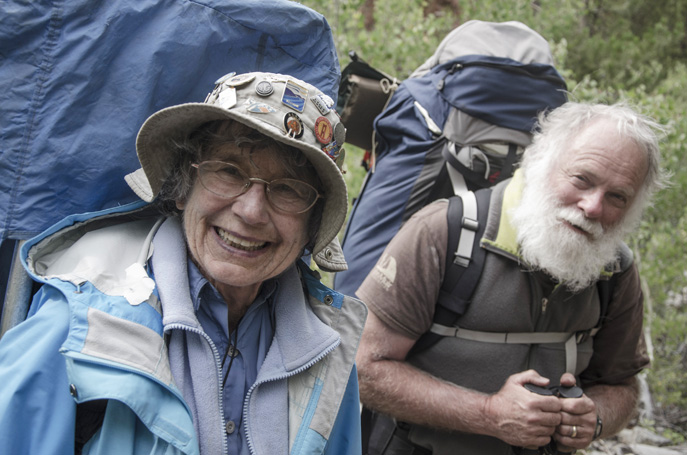
Vicky Hoover and Frank Helling. (Photo by Julia Marshall)
We make camp that night amid tall pines. After supper we pass a book of John Muir’s writings around the fire and read aloud in turn.
###
The next day starts with a grueling climb up steep switchbacks that finally level off alongside Evolution Creek, the headwaters of which rise within sight of Muir Pass at Wanda Lake, named after John Muir’s eldest daughter. We stop for lunch at 9,500-foot McClure Meadow, where the creek flattens and meanders through a broad, grassy meadow against a backdrop of high peaks.
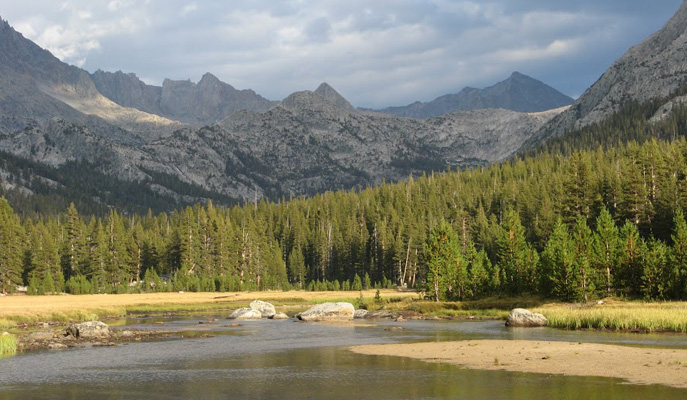
McClure Meadow. (Photo by Donn Furman)
“Some who support a hardline interpretation of the Wilderness Act of 1964 would like see the Muir Hut removed,” Harnsberger confides as we wolf down salami, cheese, bread, nuts, and dried fruit. “There’s an inherent tension between those ‘pre-existing’ cultural resources and ‘wilderness zone’ landscapes in the national parks. Some feel that all man-made structures should be removed from wilderness areas. But the Muir Hut is a significant pre-existing cultural resource—already more than 50 years old when Kings Canyon National Park wilderness was established—and a national landmark that deserves protection as a memorial to the man who did more than anyone at the turn-of-the-20th century to protect these mountains.
###
Splash! Someone has fallen into the water at the stream crossing I negotiated with difficulty about 20 seconds ago. It's Harnsberger, who's gone into the drink along with his unwieldy photo. Scrambling to his feet, he lifts it dripping from the creek. It's bent. I watch him carry it to shore, where he removes the plastic and runs his fingers worriedly over the surface of the photograph. This confident, accomplished, can-do man appears distraught, and I realize at that moment how emotionally invested he is in this monumental endeavor. But he quickly declares the photo to be OK, slides it back into his plastic sheathing, tucks it under his arm, and resumes his characteristic jaunty clip up the trail.
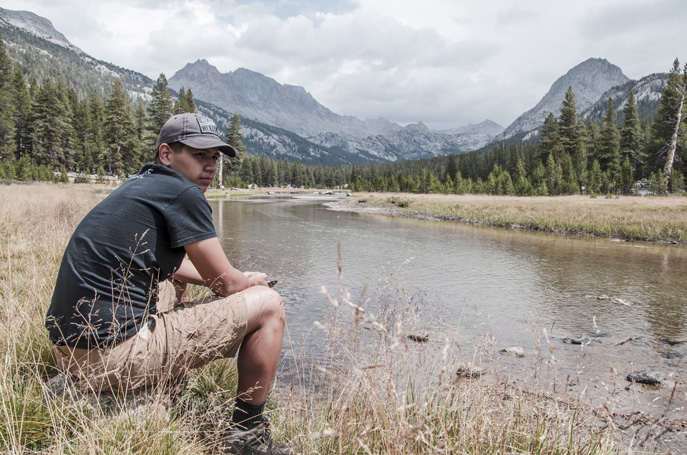
Leo Hernandez in Evolution Valley. (Photo by Julia Marshall)
We make camp at the edge of the forest in Evolution Valley. Another mid-afternoon hailstorm has left a nip in the air, and after setting up our tents we gather downed wood for a fire, which Grenier expertly nurses to life. No sooner does he get a healthy blaze going than lightning flashes, a thunderclap reverberates overhead, and the skies unleash another hailstorm, far more violent than the previous two. We bolt for the shelter of our tents.
The hail gives way to pounding rain, and suddenly water is flowing through the camp. With my fingers, I frantically dig channels to divert the water around the tent, but the downpour is unrelenting. My earthworks are quickly breached and puddles form inside the tent. I’m about to shove my sleeping bag into my backpack and lug the whole shebang to higher ground when the rain slackens, the pyrotechnics and thunder subside, and the storm moves on, rumbling grumpily as it departs.
We’re shaking the detritus off our rainflies when a saturated foursome walks out of the dripping forest into the camp: the Sierra Club contingent who hiked in from the east. I’m swapping tales with Joan and Bruce Hamilton, the former editor-in-chief of Sierra magazine and the Club’s current deputy executive director, when an ooing and aahing comes wafting from the edge of the meadow. A rainbow is arcing across the sky, touching down on either side of the canyon we must ascend to reach the Muir Hut. A propitious omen.
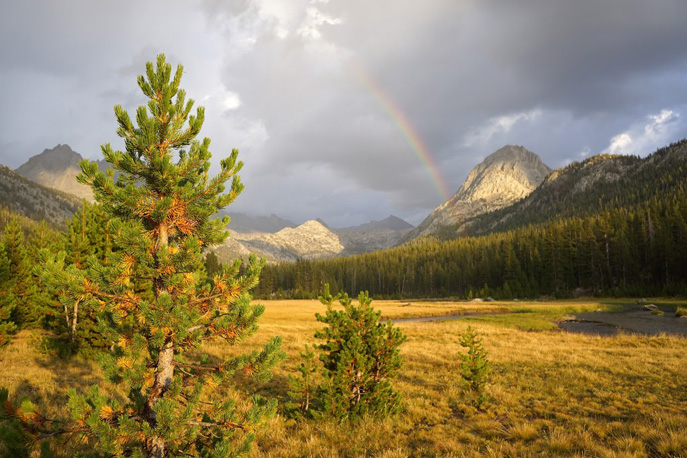
Rainbow over Evolution Valley. (Photo by Donn Furmann)
###
By lunchtime the next day we arrive at 10,852-foot Evolution Lake at the northern extremity of Evolution Basin, often called “the jewel of the Sierra.” The panorama of high peaks known as the Evolution Group—eight summits bearing the names of prominent 19th-century evolutionary scientists—is breathtaking. This will be our base camp for the next two nights, with an 11-mile round-trip jaunt up to Muir Pass sandwiched in between.
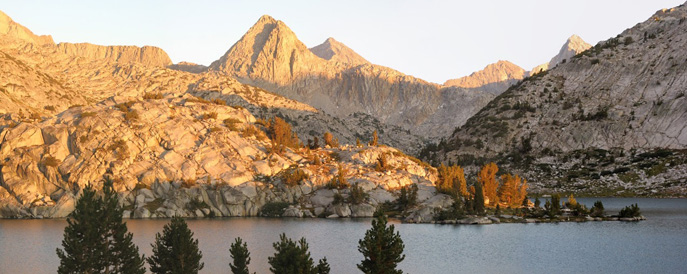
Evolution Lake. (Photo by Donn Furman)
For all but three of us, the afternoon is spent lazing about, fishing, or ambling around sans backpacks. Pushing on ahead to Muir Pass are Harnsbergers père and fils and Julia Marshall, who’s hell-bent on capturing time-lapse images of the Muir Hut with the Milky Way wheeling overhead.
I take a plunge into the shockingly cold lake and spend time talking with the septuagenarians. Hession, long retired to the Sierra foothills, tells me about his passion for running whitewater rivers in wooden dories. Helling recounts how his John Muir alter ego developed organically from leading Sierra Club outings and teaching environmental education for 25+ years. Hoover talks about climbing all 247 summits on the Club’s “Sierra Peaks” list—many of them more than once, often with her young kids in tow.
And then she adds, a tad wistfully, that this trip, a mere week before her 80th birthday, is likely to be her last self-propelled sojourn into the Sierra high country. This declaration brings me up short. I met Hoover in 1983, when she was in her late 40s and, well… a force of nature. And she still is one. “My knees just aren’t what they used to be,” she declares matter-of-factly as the light turns the granite to golden.
###
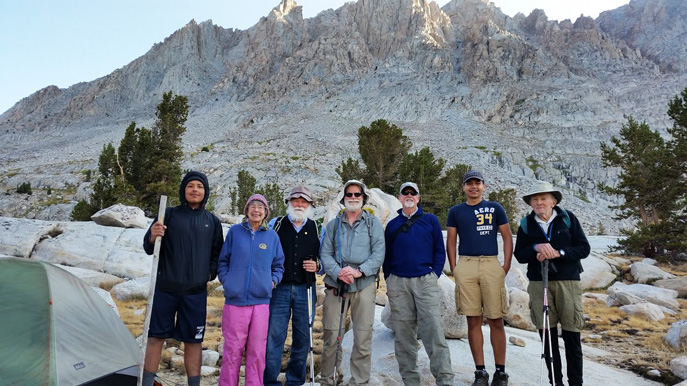
Left to right: Ramirez, Hoover, Helling, Roberts, Furman, Hernandez, and Hession. (Photo by Tom Valtin)
August 25: the National Park Service’s 100th birthday. The scenery between Evolution Lake and Muir Pass is stunning. Half a dozen dramatic, craggy peaks shove above 13,000 feet, and a series of luminous blue lakes reflect the landscape and the sky as the trail ascends from granite bench to granite bench. Hernandez and Ramirez lead the way, fueled by youth and adrenaline. Whenever we stop to rest or refill our water bottles, I see that their expressions are filled with wonder. Here are two city kids from Chicago’s West Side, utterly in their element in the High Sierra.
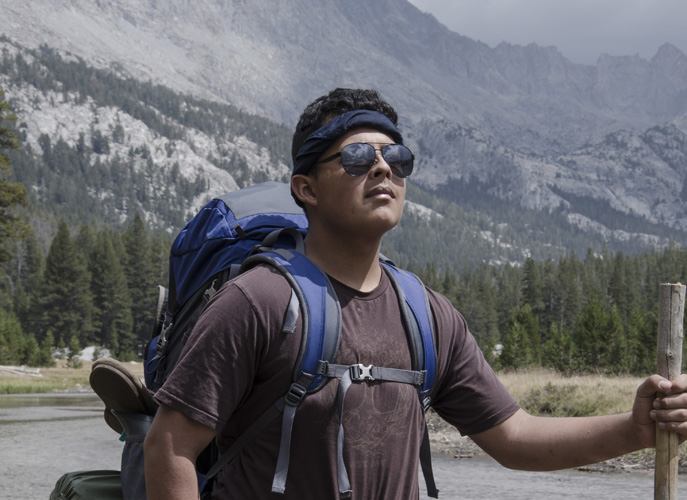
Luis Ramirez en route to Muir Pass. (Photo by Julia Marshall)
My 59-year-old legs are powering me up the trail at a healthy clip, but it’s impossible not to observe that the 78-year-old Hession, who’s following hot on my heels, seems fresher than me. Several times I ask if he’d like to pass me, but he says no, he likes my pace. Still, I can’t help but feel that I’m slowing him down. I’m totally inspired; this is what I want to be doing at age 78.
At Sapphire Lake we leave the trees behind, and by the time we reach Wanda Lake at 11,246 feet, even the grass is struggling to hold on. Truly a top-of-the-world place, all rock and water and sky. Muir Pass comes into view as we traverse the lakeshore, and we can just barely make out a small nubbin sticking up from the saddle: the Muir Hut.
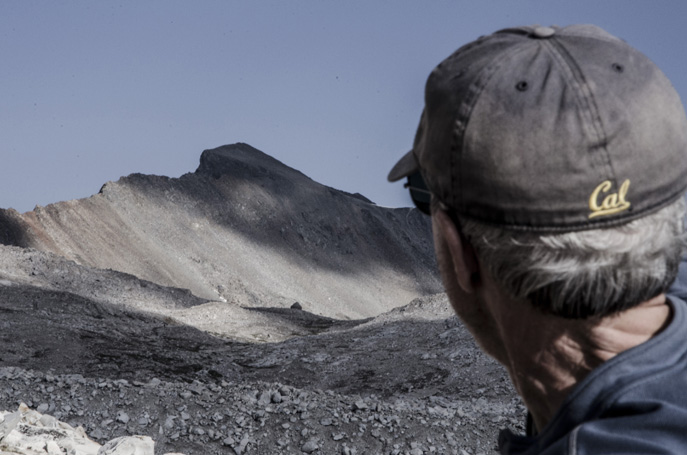
Muir Hut coming into view. (Photo by Julia Marshall)
Half an hour later we top the pass and find a buzzing crowd of a dozen Sierra Clubbers, half a dozen Park Service rangers, three mules, and a gaggle of random hikers who just happened to arrive at the right time. Harnsberger greets us effusively and points to a mule carrying wooden a box containing DiPasquale’s sculpture, which has arrived on schedule after all thanks to some expedited mule-dispatching by Sequoia/Kings Canyon superintendent Woody Smeck.
But one key component of the ceremony hasn’t arrived: John Muir. Harnsberger paces. Where is Helling? Park Service regulations prohibit this many people from lingering at the Muir Hut, but Harnsberger has secured a “special use permit,” good for an hour, from noon to 1:00. It’s now 11:30.
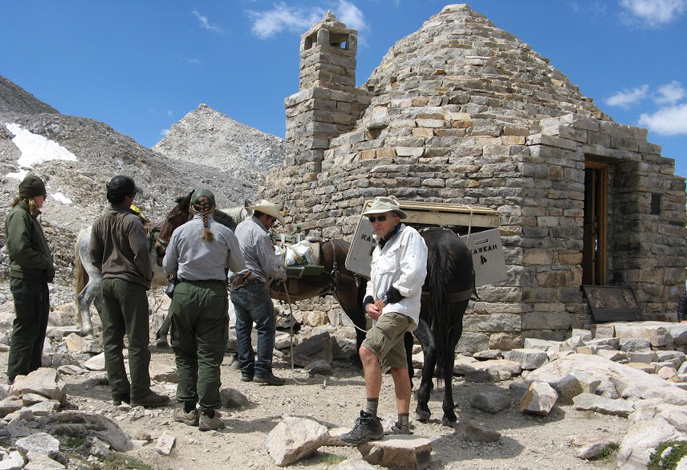
Jack Hession and National Park Service rangers at Muir Hut. (Photo by Donn Furman)
We watch as the bronze-toting mule is unburdened and six sets of strong arms—including those of Hernandez and Ramirez—muscle the plaque up the steps of the hut and position it in the doorway. We scarf down lunch as clouds scud overhead and the wind begins to pick up. It’s nearly noon; still no Helling. Harnsberger goes over his prepared remarks with Bruce Hamilton and greets a group of bewildered hikers who’ve just arrived at the pass. “We may have to start without John Muir,” Harnsberger frets.
Just then a shout goes up as Helling, Furman, and “sweeper” Dave Roberts emerge atop the switchbacks. Helling is puffing but buoyant. “I’m nae the spry lad I once was,” he says, leaning on his staff, “but here I be.” He grabs a quick bite, pulls on his John Muir garb, and the ceremony is underway.
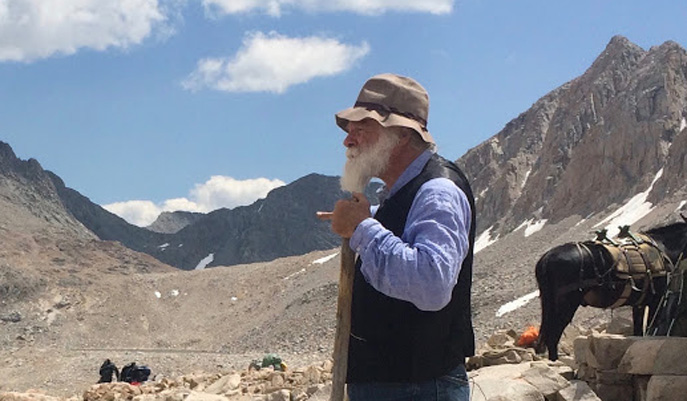
Frank Helling, aka John Muir, at Muir Hut rededication ceremony. (Photo by Donn Furman)
We sit in a semi-circle as Harnsberger recounts the history of the shelter and the new sculpture, using the photo as a visual. Helling delivers a sermon in flawless Scottish brogue, leavening his own words with Muir’s romantic incantations.
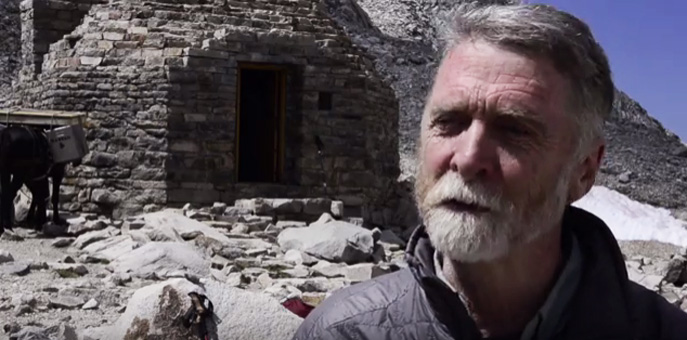
Bruce Hamilton at the Muir Hut. (Photo by Julia Marshall)
Bruce Hamilton speaks about the Sierra Club’s long association with the national parks. Then we all pack into the hut, where this writer leads the convocation in singing the traditional Scottish ballad “Loch Lomond”—taking liberties with the lyrics to fit the occasion—and Woody Guthrie’s “This Land is Your Land.”
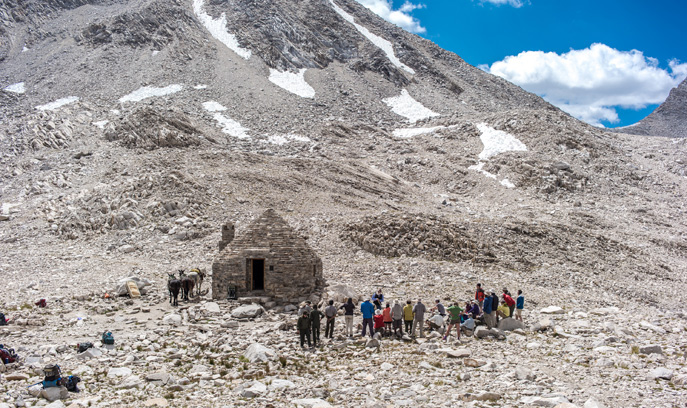
John Muir Memorial rededication ceremony, August 25, 2016. (Photo by Sherman Thomas)
A benediction from Harnsberger brings the proceedings to a close, and the John Muir Memorial Shelter officially takes its place on the nation’s list of “historic places worthy of preservation.”
###
The descent from Muir Pass back down to Florence Lake is a tale in itself, but not one to be related here.
Several weeks after our return to civilization, Harnsberger and I meet up at a watering hole near the Sierra Club's Washington, D.C., office. He’s a happy man, well and justly satisfied, but not one to kick back and rest on his laurels. “Raising funds for the hut’s masonry repointing and returning the missing finial to the apex of the roof are the next objectives,” he explains impassionedly, in quintessential architect-speak. “And after that…”
He pauses to take a long draught of his India pale ale. “I think the entire John Muir Trail deserves to be listed on the National Register, don’t you?” We clink our pint glasses together and drink to that.
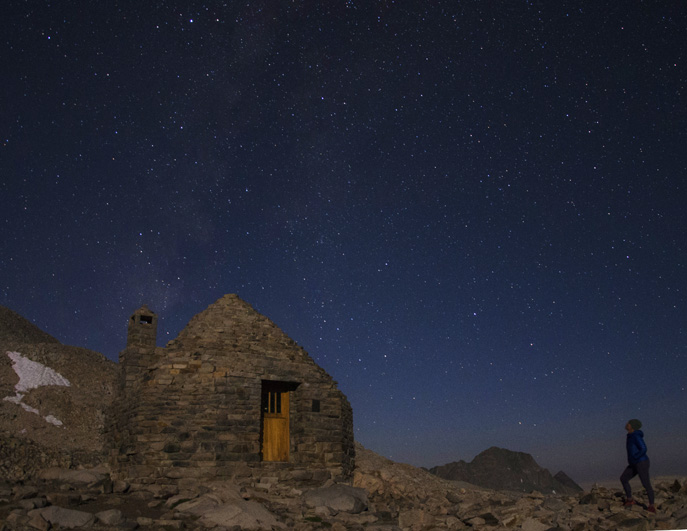
Julia Marshall at the Muir Hut. (Photo by Julia Marshall)
Watch our short video produced by Julia Marshall
###
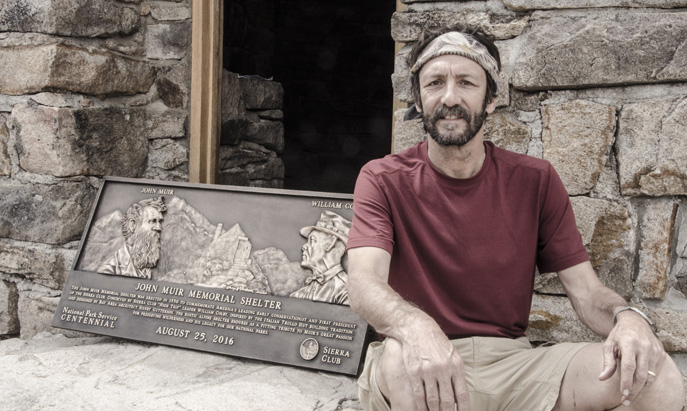
Photo by Julia Marshall